|
|
|
|
 Swiftech MCX462-V Heatsink Review Swiftech MCX462-V Heatsink Review
|
|
Date Posted: Dec 1 2003
|
|
Author: pHaestus
|
|
|
|
|
Posting Type: Review
|
|
Category: Air Cooling Reviews
|
|
Page: 1 of 1
|
|
Article Rank:No Rank Yet
Must Log In to Rank This Article
|
|
|
|
|
Note: This is a legacy article, imported from old code. Due to this some items on the page may not function as expected. Links, Colors, and some images may not be set correctly.
|
|
|
Swiftech MCX462-V Heatsink Review By: pHaestus
|
|
 |
|
Swiftech has produced high end air, liquid, and TEC-based cooling solutions for many years. The MC462 heatsink from Swiftech has the distinction of being the
first AMD heatsink to utilize the four socket holes for its retention mechanism. This heatsink has undergone several revisions over time, with changes in pin design (smooth to helicoid), baseplate thickness, and bundled fan.
I have personally used and tested an MCXC370 and a MCX462 heatsink in the past and my opinion was that the fins were so tightly packed that it was difficult to
achieve suitable airflow all the way to the base plate. Hot air tended to stagnate near the base as a result, and performance was really only good when high CFM fans were employed. This made the earlier Swiftech MCX series
heatsinks good "overclocker" coolers, but not perhaps so useful if quiet computing is your goal. I had assumed that Swiftech would eventually switch to either smaller or fewer fins to perform low CFM performance, but I was
wrong. Instead Swiftech has hit upon some rather clever ways to maintain high surface area and increase airflow through the fins with their latest iteration - the MCX462-V.
|
|
And that brings us to the topic of the day: The MCX462-V, Swiftech's newest AMD heatsink.
|
|
|
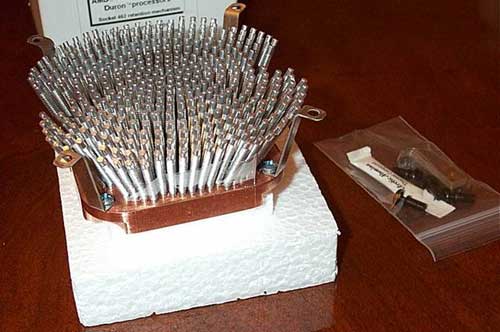 |
|
|
At first glance this heatsink seems pretty similar to their previous offerings: thick copper base, aluminum helicoids pins screwed into the base, and the same
aluminum standoffs for fans. But in fact this heatsink is a departure from previous designs in two major ways. First of all, the MCX462-V uses clips that attach it to the motherboard's socket lugs instead of bolting through the
four mounting holes. Swiftech's rationale is that AMD no longer includes the mounting holes as part of their official specifications. The other difference is that the fins are not perpendicular to the base but instead are bent
out in concentric circles. A picture is worth a thousand words in this case.
|
|
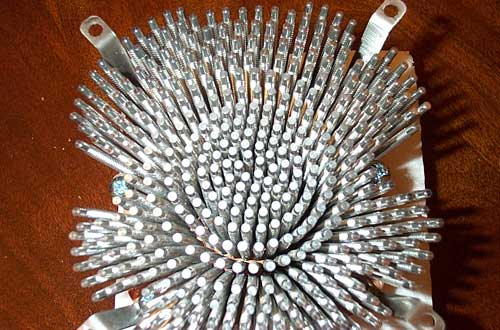 |
|
|
This design has two advantages. There is now more space between the pins for air to move, and therefore it is expected that low CFM performance will be
improved. The other advantage is that the heatsink can accept 92mm fans without being extremely large at the base. Speaking of the base, the MCX462-V has an extremely flat base as is typical for Swiftech products. The sticker
that provides guidance on "which end is up" is a new touch, however.
|
|
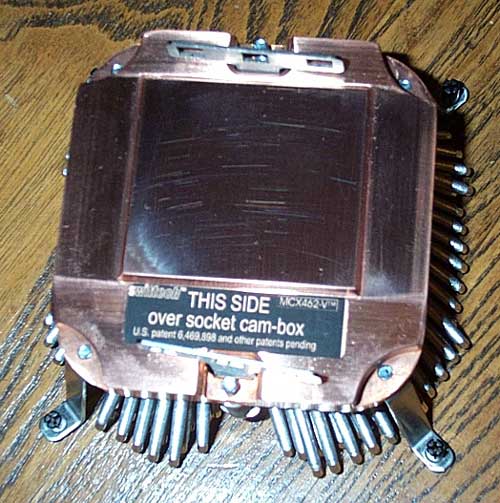 |
|
|
|
Installation and Ease of Use
|
|
Unlike most reviewers, I install heatsinks into a fully built computer prior to testing. I was not impressed when I installed the MCX462-V for the first time.
Since the base is wider than the socket, it is difficult to actually see whether the clips are engaged on all the socket lugs or not. And since the heatsink base is actually a pretty tight fit around all the capacitors on my
motherboard (Epox 8K3A), it was not trivial to get the heatsink properly on the lugs on both sides. After finally fiddling a bit, I had no problems increasing mounting pressure with the spring loaded screws. Removing the
heatsink for the first time was also a pain because there wasn't enough room between the copper base and the capacitors to tilt the heatsink very far. After repeating the mounting one or two additional times, I eventually got
the hang of it. With repeated testing I could get fairly reproducible temperatures, but I feel I could have done better if I hadn't had to battle with the socket clips every time.
It is a real shame that Swiftech no longer supports AMD 4 hole mounting.
I understand that Swiftech only builds heatsinks to official AMD and Intel standards and that AMD deleted the socket hole requirement. Having said that, I think this is a bad decision on Swiftech's part. They aren't selling these heatsinks to cheapo oem builders and people running generic motherboards; they are selling them to the higher end enthusiast market. The first thing I look at when buying an AMD motherboard is whether it has the 4 holes for proper waterblock and heatsink mounting.
I spoke with Swiftech about my wish for socket holes and was told that the angled pins of the MCX462-V are not ideal for socket hole mounting. To use the
mounting holes on this heatsink then one would have to cut away so many pins that performance actually suffers. The only thing that could make me give up using socket holes is "better cooling", so I guess I can understand.
The other item to be installed after the heatsink is mounted is the fan. Swiftech included standoffs for both 80mm and 92mm fans as well as some black plastic
pieces to hold the fan down. The plastic pieces are the exact same parts used to hold fans in place on Lian Li cases, by the way. They work acceptably well the first time that a fan is installed, but I quickly realized that I
was never going to be able to swap fans while testing with them. Instead I used some 2" bolts. This worked much better.
|
|
A variety of tests were performed to gauge the heatsink's performance on an AMD system. An Epox 8K3A motherboard was used as the test platform after
modification of the socket pins to remove the contacts of the motherboard's internal diode reading circuitry. CPU diode readings were obtained by soldering 5" of twisted pair copper wire to (a) the diode pins of a 1700+ JIUHB
stepping Thoroughbred B processor and (b) a Maxim MAX6655 evaluation system (0.125C resolution). The air temperature 1" from the intake of the heatsink fans was measured at a slight offset from the center of the fan with a
Digitec 5810 dual linear thermistor (0.01C res) with a YSI 703 probe.
A special formulation of thermal paste (termed "BillA Goop") was used for all tests. This paste is designed to minimize the settling time required for
consistent temperature measurements. Heatsink mounting was repeated five times, as follows. Heatsink base and CPU were cleaned with a lint-free cloth to remove paste, paste was reapplied, heatsink was remounted, and the PC was
allowed to idle at 2200MHz, 1.85V for exactly 12 hours prior to testing. The processor was then placed under load using K7Burn in High Priority. Both CPU and intake air temperatures were collected after 30 minutes of load.
To test the performance of the MCX462-V over a wide range of CFM, the 92mm Vantec Tornado fan was controlled via PWM to run at 5, 10, 25, 35, 50, 75, and 100%
duty using a Crystalfontz 633. 30 minutes were taken for each fan speed. The performance of several other fans was also tested with the MCX462-V: 80mm Panaflo L1A, NMB, Vantec Tornado, and 92mm Vantec Stealth. Specifications of
all the fans tested are included in a table with the test results.
To change fans without affecting the thermal paste application, 2" bolts were placed through the fan standoffs of the heatsink and held into place with nylon
nuts. Fans could be placed gently down over these bolts and then secured in place with the brass nuts from a Dangerden Maze 4 mounting kit.
|
|
One of the most useful tests to perform with a heatsink is to learn how it performs with a variety of common fans. The goal is to give readers the ability to
choose a target noise level or performance level and purchase fans accordingly. The results of the MCX462-V performance with fans ranging from 24 to 119 CFM are shown in the table below.
|
|
|
|
|
|
|
 |
|
|
|
|
|
Delta T refers to TCPU – Tintake, in degrees C. Standard deviation (after five replicates) ranged from 0.49 to 0.52C for all fans.
The fans tested tend to cluster at either the extremely quiet or the extremely loud end of the spectrum; regrettably I don't have any medium CFM fans with which to test. Nonetheless there is an observation that can be teased
out of the results that is extremely important.
The 80mm low noise fans (L1A and NMB) perform significantly better than the 92mm quiet fan (Vantec Stealth) even though they are both lower CFM. The 80mm Vantec
Tornado also moves about 35 CFM less air than the 92 Tornado does, but it performs better. The take home message is that even when heatsinks can accept a 92mm fan that the 80mm fan may often be a better choice. I looked up
static pressures for several of the fans and they increase from 80mm to 92 mm (as one would expect) so that is not the explanation. Instead, I suspect that the 92mm fans have a larger "dead zone" in the center, and that in the
center of the heatsink is precisely where airflow is needed. Whatever the reason, 80mm fans are usually quieter, cheaper, and more readily available than 92mm fans and the fact that they also perform better makes this pretty
useful information.
Another test that proves useful is to vary the performance of a powerful fan by using pulse width modulation (PWM). It was possible to adjust the 92mm Vantec
Tornado from 5% to 100% duty using the WinTest software provided with the Crystalfontz CF633.
|
|
|
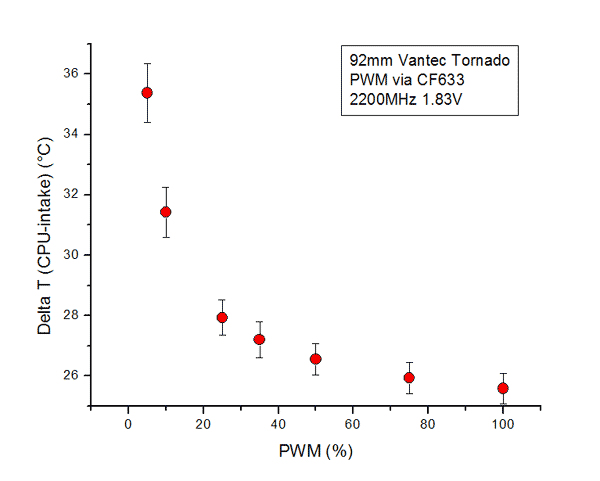 |
|
|
There are two items of note in this graph. First of all, performance drops off considerably below 25% PWM. This implies that with the MCX462-V that there is
some minimum amount of airflow needed to perform acceptably. No surprise there. The other item of note is that the MCX462-V performs extremely well in the 25-100% PWM range. This is a huge range of airflow. Other reviewers have
billed this as a heatsink for all users, and I can see why provided you don't go below a certain airflow threshold.
While the PWM numbers and the different fan performance numbers are useful on their own, they really become illustrative of this heatsink's performance when
analyzed together. To do so, I estimated what %PWM would yield the same performance as was observed for all the fans tested. Then I was able to plot the performance of the various fans on the same PWM% graph shown earlier.
|
|
|
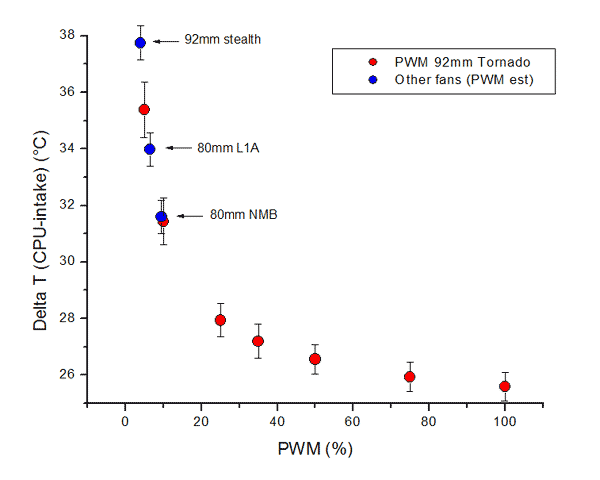 |
|
|
When this is done then it becomes clear where the "quiet cooling" category of fans stack up compared to more powerful units. The 80mm NMB fan and the 80mm
Panaflo L1A fare much better than the 92mm Stealth, and my ear couldn't tell the noise levels of the NMB, the stealth, or the Panaflo apart. Based upon these results, the 80mm NMB is a very attractive fan to pair with the
MCX462-V for the quiet cooling aficionados.
Speaking of noise, there is an important thing to consider when trying to achieve quiet cooling. When I adjusted the 92mm Tornado to speeds comparable to the
NMB, L1A, or Stealth, it was MUCH noisier than the quiet 80mm fans. At all PWM speeds there was quite noticeable motor noise coming from the Tornado. If you decide to buy a loud fan and use a fan controller to adjust it down in
noise, you are going to deal with much more noise than someone that just buys a quiet fan that performs similarly. Fan controllers work fine for turning down screaming fans during phonecalls or movies, but they are not really
going to ever provide silent computing when throttling louder fans.
The final sets of tests that I ran were to see how delta T changed with CPU speed and voltage. I had high hopes of using W estimated from my MCWChill testing to
determine CPU wattage and estimate C/W. That didn't work out especially well (for reasons to be discussed in the MCWChill writeup) but the data may prove interesting to some.
|
|
|
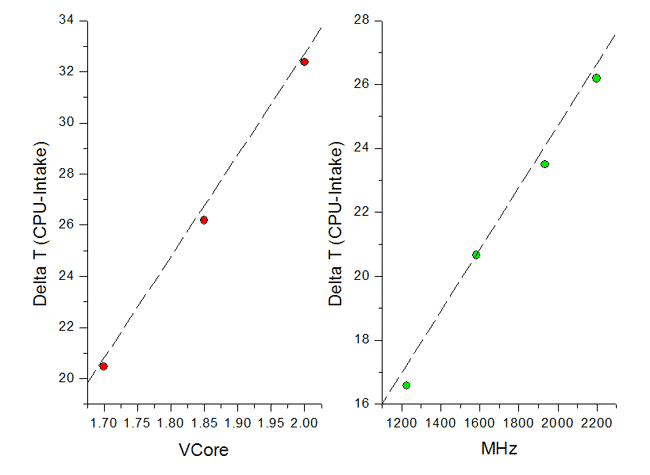 |
|
Nothing too surprising in the results; voltage increases play a larger role in CPU heat than ramping up clock frequencies. We all know this.
|
|
|
- Performance with a variety of fans suggests that, surprisingly, 80mm fans perform better than 92mm fans on this heatsink. Since maximum
pressure increases with fan size (at least when comparing specs of the Panaflo L1As from Panasonic's site) then my guess is that the larger dead zone in the center of 92mm fans is limiting performance. This is a very
important point to note, as it means that you can get more cooling at lower noise levels by going with an 80mm low noise fan! It also means that just buying the biggest and loudest 92mm fan for this heatsink is the wrong
approach for top performance. I am a little tempted to see if I could improve 92mm fan performance with a 2 inch (50mm) duct, but this would mostly be academic since users couldn't fit such a monstrosity in their PC
enclosures.
- If you are looking for a balance of noise and performance, then buying a loud and powerful fan and throttling it with PWM or voltage
adjustment is a mistake. In other words, loud fans being adjusted with PWM are almost always louder per CFM than fans designed to run at the same CFM. At all PWM levels, the 92mm Vantec Tornado fan was louder than a
comparable fan that performed the same at 12V. When making fan purchases for a heatsink, I suggest that you make an honest assessment of both your performance needs and your noise tolerance. There are no free rides here;
you can't have the best of both. If you find yourself throttling the fan back to achieve more reasonable noise levels, then you should seriously consider shopping for a fan that's about as quiet at 12V.
- For quiet computing the 80mm Panaflo L1A or the 80mm NMB fan that Swiftech recommends would be good choices. I would lean towards the L1A
myself because they are slightly quieter and often available at electronics surplus sites for $2-3US. For moderate performance/noise levels, I would recommend (based upon personal experience with other heatsinks) a fan in
the 40-50CFM range with as little noise as possible. Good choices are the Sunon 50CFM (model #xxx) and the Panaflo H1A.
- For top performance at any (noise) cost, the 80mm Vantec Tornado is the top performing fan I have tested. I would expect that the 80mm
Delta EHE (80CFM) would perform similarly well. I must caution everyone that these fans sound quite a lot like hair dryers; I wouldn't want one running all day near my ears (or in the same room even). They honestly make the
38CFM Delta black label fans we all used to use sound pleasant. I don't know if anyone other than heatsink testers actually uses these on a daily basis; if so I fear for their sanity.
|
|
|
|
I also want to give a final assessment of the MCX462-V heatsink, since it is the proper topic of this review. This heatsink is a large improvement over
previous Swiftech designs for normal (read non EHE and Tornado) users, and as long as you are willing to remount a few times to get best temps then it is highly recommended.
It's a bit more expensive than some of the other high end heatsinks, but the machining and finish is also better. I have also found that Swiftech heatsinks hold up very well over time so you get what you pay for. The older MCX462 was a pretty poor choice for low noise applications, but the changes to the new MCX462-V make it capable of very good cooling with fans rated at ~25CFM and up. I am personally going to put the MCX462-V in my HTPC with the NMB fan because I think it will do quite a bit better than the Thermalright SLK800/Panaflo L1A I am using in that PC right now.
|
|
|
|
| Random Forum Pic |
 |
| From Thread: I need help with a basic circuit |
|
| | ProCooling Poll: |
| So why the hell not? |
|
I agree!
|
 67% 67%
|
|
What?
|
 17% 17%
|
|
Hell NO!
|
 0% 0%
|
|
Worst Poll Ever.
|
 17% 17%
|
Total Votes:18Please Login to Vote!
|
|






 Swiftech MCX462-V Heatsink Review
Swiftech MCX462-V Heatsink Review







